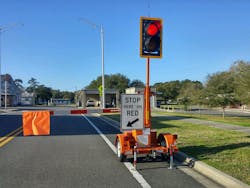By Mark Ludewig, Contributing Author
Today is “Go Orange Day.” National Work Zone Awareness Week (NWZAW) and Go Orange Day are important to the families of victims who have lost their lives in work zones. You can wear orange to proudly show your support as well as post on social media using the hashtags #NWZAW and #Orange4Safety.
Go Orange Day also provides us with an opportunity to raise awareness of the latest traffic control technologies and devices that help to accommodate the safe construction of roads, bridges, and other infrastructure.
Technology can increase the effectiveness of properly conceived work zones. One important trend is the growing influence of autonomous devices that can enhance site safety. These technologies are popping up everywhere from highways to intersections under repair, and they can help direct and inform drivers about conditions while also alerting workers to dangers.
Automated Flagger Assistance Devices (AFADs) are robotic arms that help control traffic in the same way that a human flagger can. These arms are programmed with a variety of motions, such as raising and lowering, making sweeping motions and flashing colored signals. The advantage is that AFADs can be programmed to work in any type of weather or temperature, meaning that the human flaggers do not have to be exposed to potentially dangerous conditions. AFADs can be monitored by a human operator standing at a safe distance or, other times, without the need for an operator to be present. Furthermore, automated flaggers require minimal maintenance and operator training.
Portable temporary rumble strips are an often-overlooked solution for managing traffic flow, and their use is now required by many states in work zones. These plastic or polymer strips create a groove-like effect over asphalt or concrete surfaces and are relatively inexpensive compared to traditional traffic control measures. The relatively small size and light weight of these temporary strips makes them a cost-effective option to installing traditional rumble strips.
Cushioned impact attenuators or “crash cushions” are also increasingly used as temporary installations to protect motorists and highway workers. These fully redirective attenuators can be attached to most types of roadside barriers to automatically regulate the stopping force exerted on a vehicle as well as lessen the risk of a vehicle rebounding after impact. Unlike fixed-resistance attenuators, a cushioned attenuator does not reach maximum stopping resistance unless a vehicle is traveling at the maximum design speed. National Cooperative Highway Research Program (NCHRP) crash performance testing shows that crash cushions are breaking new ground in significantly lowering vehicle deceleration rates and reducing impact forces.
New technologies are benefiting motorists and highway workers alike by providing a more consistent means of controlling traffic flow in work zones. Working in active construction zones is one of the most hazardous occupations in America, and unfortunately accidents still occur with alarming regularity. R&B
Mark Ludewig is the vice president of Safety for AWP Safety.



